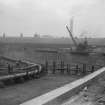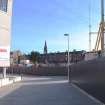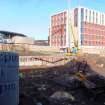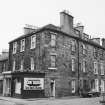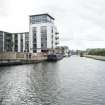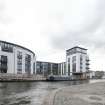Edinburgh, Lower Gilmore Place, Lochrin Basin, Old
Buried Land Surface(S) (Period Unassigned), Canal Basin (19th Century), Ditch (Period Unassigned), Engine House (18th Century), Post Hole(S) (Period Unassigned)
Site Name Edinburgh, Lower Gilmore Place, Lochrin Basin, Old
Classification Buried Land Surface(S) (Period Unassigned), Canal Basin (19th Century), Ditch (Period Unassigned), Engine House (18th Century), Post Hole(S) (Period Unassigned)
Alternative Name(s) 2 Lower Gilmore Place
Canmore ID 52691
Site Number NT27SW 64
NGR NT 24663 72766
Datum OSGB36 - NGR
Permalink http://canmore.org.uk/site/52691
- Council Edinburgh, City Of
- Parish Edinburgh (Edinburgh, City Of)
- Former Region Lothian
- Former District City Of Edinburgh
- Former County Midlothian
The original Lochrin Basin is clearly marked on the 1sr Edition of the OS 6-inch map (Edinburghshire 1855, sheet 2).
Information from RCAHMS (MD) 23 January 2001.
Elements of the original basin, filled in during the 1930s, have been revealed during the re-development of the former Armold Clark garage. An inset ring and part of the quayside were revealed.
Information to RCAHMS from Mr C Hill via e-mail, 29 August 2005
Watching Brief (August 2005 - October 2005)
NT27SW 64 2460 7270.
Watching brief; evaluation NT 246 727 Due to the proximity of the Union Canal (NT27SW 39 and 83), a Scheduled Ancient Monument, a watching brief was carried out between August and October 2005 during the demolition of buildings and associated groundbreaking works on the Lochrin Place development site. Part of the walls of the basin and the S side of the basin bridge were recorded.
An evaluation was subsequently carried out. Sections of the walls of the basin were exposed, as well as sections of walls of other buildings contemporary with the basin. A large number of ceramic fragments were recovered from the bottom fill of the basin.
Archive to be deposited in NMRS.
Sponsor: M & M Lochrin Development Ltd.
D Wilson and P Trickett 2005
Excavation (2 March 2009 - 27 March 2009)
NT 246 727 An excavation was carried out 2–27 March 2009 on a development site at Lochrin Place. The work was considered necessary due to the proximity of the early 19th-century Lochrin Basin, formerly part of the Union Canal. The excavation recorded part of the southern extent of the canal basin quay wall, and the fragmentary remains of concrete and mortar floors, cobbled surfaces and walls associated with a building. The walls were probably the remains of ancillary structures, possibly warehousing, associated with a rope making factory located immediately to the S of Lochrin Basin.
Archive: RCAHMS (intended)
Funder: Mactaggart and Mickel Ltd
Alan Hunter Blair – AOC Archaeology Group
Excavation (November 2012 - 30 January 2013)
NT 2466 7276 An excavation was carried out, November 2012 – January 2013, on the site of proposed student accommodation at Lochrin Place, 19 West Tollcross. Cartographic evidence shows the area lies to the N of the former Lochrin Basin and overlies buildings dating from the mid-19th century, including structures associated with a distillery, brewery and iron foundry. The excavations found that the wall foundations, floor surfaces and machine bases of the various phases of buildings survive intact, though the central area of the site has been heavily truncated.
A considerable depth of garden soil was recorded at 3.7m below the current ground surface. This might be associated with gardens shown on early 19th-century maps of the site. Two deposits of buried horticultural soil were visible; the upper deposit contained pottery dating to the 17th to early 18th century. The underlying deposit was lighter in colour and contained pottery dating from the 12th to 15th century. A large ditch, pits and postholes were cut through the earlier garden soil.
Archive: RCAHMS (intended)
Funder: Watkin Jones Group Ltd
Laura Bailey, Headland Archaeology Ltd, 2013
(Source: DES)
OASIS ID: OASIS ID: headland1-144811
Note (19 June 2014)
Lochrin Basin was, with Port Hopetoun, an original basin for the Edinburgh and Glasgow Union Canal when opened in 1822. All the Edinburgh basins (incuding the later Port Hamilton basin) were closed in 1922 as the canal usage had steadily declined since 1846 (when the railway came).
Lochrin, along with Port Hamilton and Port Hopetoun were filled in. By the tie of its closure, Lochrin Basin would have been surrounded by rather tumbledown buildings.
In 1922 a new eastern terminus basin (NT27SW 83.06) was established and given the name Lochrin Basin.
G Hutton, 1993
Excavation (13 April 2015 - 13 May 2015)
An archaeological excavation was undertaken on the site of a proposed re-development at Lochrin Basin (Lochrin Place), Edinburgh. The proposed building footprint was to be fully excavated in order to record the remains of the former canal basin walls and deposits. The northern wall and entrance to the basin were revealed within the excavation area along with several metres of early 20th century and modern backfill, overlying the original basin silts and clay floor. The basin silt contained numerous ceramic artefacts, such as teapots, plates, bottles and jars as well as several glass and metal objects, and several well worn leather shoes. All the items would have related to discarded objects from people on the barges or by the distillery. Furthermore, a series of 24 timber posts were also revealed to the E end of the basin excavations, representing the former wharf or quay location. Finally, out with the basin, the remains of the 18th century engine house, thought to relate to the brewery and early distillery was also revealed.
Informatino from Kevin paton (AOC Archaeology Group) 15 May 2015.
OASIS ID: aocarcha1-211232
Watching Brief (29 September 2015 - 2 December 2015)
NT 24699 72767 A watching brief was undertaken, 29 September – 2 December 2015, during the initial construction phases of a new development at Lochrin Basin. This work follows on from a excavation of the proposed building footprint (DES 2015, 76).
The work fully exposed the canal basin and fully excavated all the deposits within. The exposure of the structure has shown the basin footprint still exists in situ, but has been truncated throughout, with the wall reduced in height (up to 1.5m in places). The best surviving portion is at the W edge where the original coping stones survive in situ, and have been built upon by a later sandstone structure, now demolished. As well as the full exposure of the basin, the steam engine structure partly located in the excavation was also fully exposed and recorded. No artefacts were recorded from the basin deposits.
Finally, two areas of existing basin wall were removed by the construction works. A full survey of the remaining basin structure has been created for future reference.
Archive: NRHE
Funder: Knightsbridge Student Housing Ltd
Kevin Paton and Martin Cook – AOC Archaeology Group
(Source: DES, Volume 17)
















